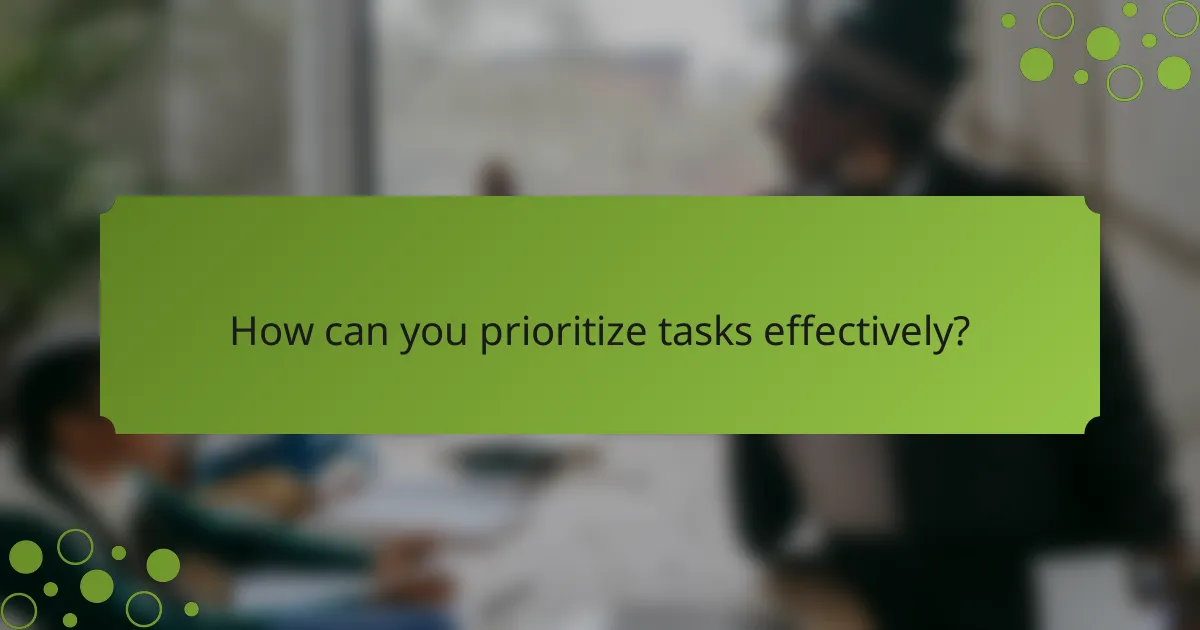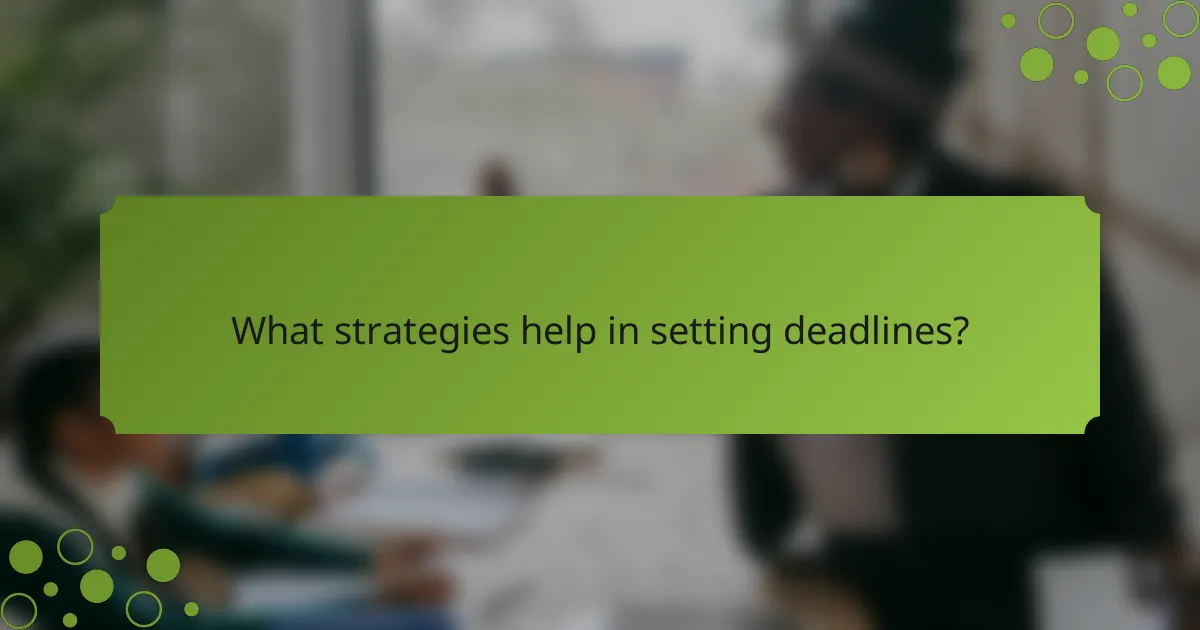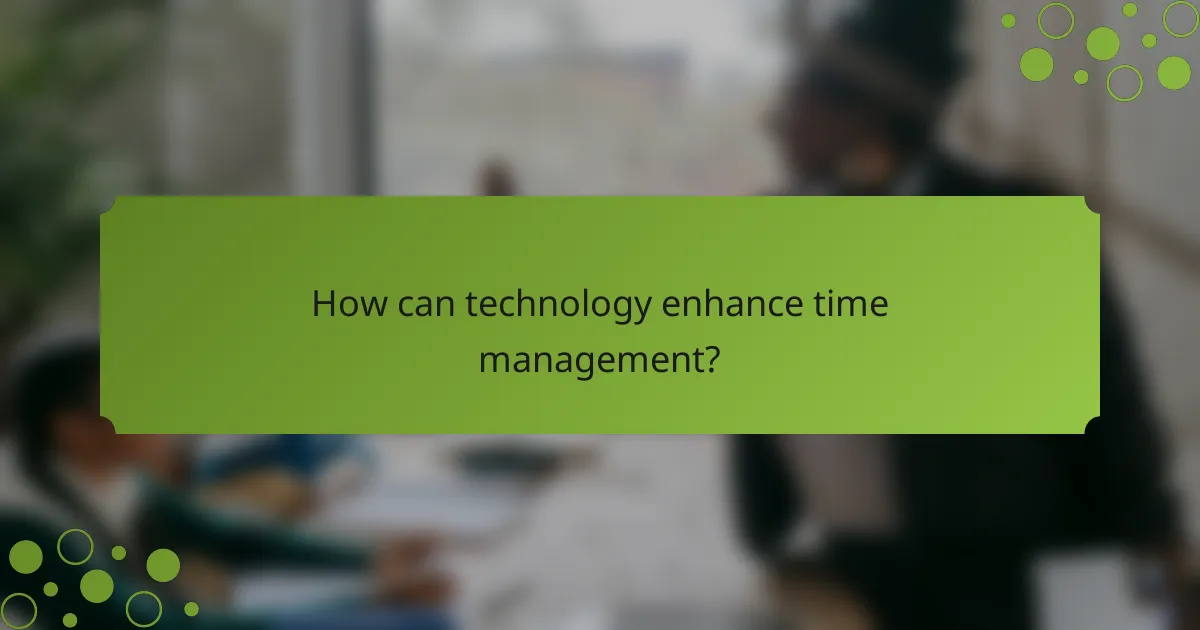
Time management is essential for achieving personal and professional goals, and it begins with prioritizing tasks based on their urgency and importance. By setting clear deadlines and employing effective strategies, you can enhance productivity and minimize procrastination. Implementing these techniques not only helps you stay focused but also ensures that you complete critical tasks in a timely manner.

How can you prioritize tasks effectively?
To prioritize tasks effectively, assess their urgency and importance, enabling you to focus on what truly matters. This approach helps manage your time better and reduces stress by ensuring that critical tasks are completed first.
Eisenhower Matrix
The Eisenhower Matrix categorizes tasks into four quadrants based on urgency and importance. Tasks are divided into: urgent and important, important but not urgent, urgent but not important, and neither urgent nor important. This visual tool helps you decide what to focus on, delegate, or eliminate.
For example, a task like preparing for an upcoming presentation is both urgent and important, while checking emails may be urgent but not crucial. Aim to spend more time on tasks in the first two quadrants.
ABC Method
The ABC Method involves labeling tasks as A (high priority), B (medium priority), or C (low priority). This simple system helps you quickly identify which tasks require immediate attention and which can wait. Start your day by tackling A tasks first.
To implement this, list your tasks and assign each a letter. For instance, completing a project report might be an A task, while organizing files could be a C task. This method encourages focus on what drives your goals forward.
MoSCoW Method
The MoSCoW Method prioritizes tasks into four categories: Must have, Should have, Could have, and Won’t have. This framework clarifies what is essential versus what is desirable, helping you allocate resources effectively.
For example, meeting a project deadline is a “Must have,” while adding extra features could be a “Could have.” Use this method to ensure that your efforts align with your overall objectives and deadlines.
Time Blocking
Time Blocking involves scheduling specific blocks of time for each task or group of tasks throughout your day. This technique helps minimize distractions and creates a structured approach to your workload.
For instance, you might allocate 9 AM to 11 AM for focused work on a report and 1 PM to 2 PM for meetings. Stick to these time slots to enhance productivity and reduce the temptation to multitask.
Task Batching
Task Batching groups similar tasks together to complete them in one go, reducing the mental load of switching between different types of work. This method is particularly effective for repetitive tasks like responding to emails or making phone calls.
For example, set aside a specific time each day to handle all emails rather than checking them sporadically. This approach can save time and improve focus, allowing for deeper work on more complex tasks afterward.

What strategies help in setting deadlines?
Effective strategies for setting deadlines include defining clear goals, understanding the time required for tasks, and applying structured techniques to enhance productivity. These methods help individuals manage their time efficiently and reduce the likelihood of procrastination.
SMART Goals
SMART goals are specific, measurable, achievable, relevant, and time-bound objectives that provide clarity and direction. By setting deadlines that adhere to this framework, individuals can ensure that their tasks are realistic and aligned with their overall objectives.
For example, instead of stating “I will finish my project,” a SMART goal would be “I will complete the first draft of my project by next Friday.” This specificity helps maintain focus and accountability.
Parkinson’s Law
Parkinson’s Law states that “work expands to fill the time available for its completion.” This principle suggests that setting shorter deadlines can increase efficiency and focus. By limiting the time allocated for a task, individuals are often compelled to work more diligently.
A practical approach is to halve the time you initially estimate for a task. If you think a report will take two weeks, try to complete it in one week instead. This can lead to improved time management and reduced procrastination.
Reverse Planning
Reverse planning involves starting with the final deadline and working backward to identify key milestones and tasks. This technique helps clarify the steps needed to meet the deadline and ensures that all necessary actions are accounted for.
For instance, if a project is due in a month, break it down into weekly goals, such as research, drafting, and revisions. This method provides a clear roadmap and helps prevent last-minute rushes.
Time Estimation Techniques
Accurate time estimation is crucial for effective deadline setting. Techniques such as the Pomodoro Technique or time blocking can help individuals gauge how long tasks will take and allocate time accordingly.
Using the Pomodoro Technique, for example, involves working for 25 minutes followed by a 5-minute break. This can help maintain focus and provide a realistic sense of how much can be accomplished in a given timeframe. Regularly reviewing and adjusting your estimates based on past experiences can further enhance accuracy.

How can you avoid procrastination?
Avoiding procrastination involves implementing strategies that help you stay focused and motivated. By using techniques like time management and accountability, you can effectively reduce delays and enhance productivity.
Pomodoro Technique
The Pomodoro Technique is a time management method that encourages working in short bursts, typically 25 minutes, followed by a 5-minute break. This approach helps maintain focus and prevents burnout, making it easier to tackle tasks without feeling overwhelmed.
To implement this technique, set a timer for 25 minutes and concentrate on a single task until the timer goes off. After completing four cycles, take a longer break of 15 to 30 minutes to recharge.
Accountability Partners
Having an accountability partner can significantly reduce procrastination by providing external motivation and support. This person can help you stay on track with your goals and deadlines, making it harder to put off tasks.
Choose someone who shares similar objectives or understands your work style. Regular check-ins, whether daily or weekly, can help maintain momentum and encourage you to complete your tasks on time.
Setting Small Goals
Breaking larger projects into smaller, manageable goals can make tasks feel less daunting and more achievable. Small goals provide a clear path forward and create a sense of accomplishment as you complete each one.
For instance, instead of aiming to finish an entire report, set a goal to write one section or gather necessary data. This method helps maintain motivation and reduces the likelihood of procrastination.
Eliminating Distractions
Identifying and removing distractions is crucial for maintaining focus and avoiding procrastination. Common distractions include social media, notifications, and a cluttered workspace.
To minimize interruptions, consider creating a dedicated workspace, turning off notifications on your devices, and using website blockers during work hours. Establishing a distraction-free environment can significantly enhance your productivity and help you stay committed to your tasks.

What frameworks support effective time management?
Effective time management frameworks help individuals prioritize tasks, set deadlines, and avoid procrastination. By implementing structured approaches, you can enhance productivity and ensure that important tasks receive the attention they deserve.
Agile Time Management
Agile time management focuses on flexibility and adaptability, allowing you to respond to changing priorities quickly. It emphasizes iterative progress through short cycles, often called sprints, which typically last from one to four weeks.
To implement Agile time management, start by defining your goals and breaking them into smaller, manageable tasks. Regularly review your progress during sprint meetings, adjusting priorities as needed to stay aligned with your objectives.
Common pitfalls include overcommitting during sprints and neglecting to reassess priorities frequently. To avoid this, keep your task list realistic and ensure regular check-ins to maintain focus.
Kanban System
The Kanban system is a visual framework that helps manage workflow by using boards to track tasks. Each task is represented by a card, which moves through various stages of completion, such as “To Do,” “In Progress,” and “Done.”
To use Kanban effectively, create a board that reflects your workflow and limit the number of tasks in each stage to avoid bottlenecks. This helps maintain a steady flow of work and encourages you to complete tasks before taking on new ones.
Be cautious of allowing too many tasks to pile up in one column, as this can lead to overwhelm and decreased productivity. Regularly review your board to ensure tasks are moving smoothly and adjust limits as necessary to optimize your workflow.

How can technology enhance time management?
Technology can significantly enhance time management by providing tools that help prioritize tasks, set deadlines, and reduce procrastination. By leveraging various applications and tools, individuals can streamline their workflow and maintain focus on their objectives.
Task Management Apps
Task management apps are designed to help users organize and prioritize their tasks effectively. These tools often allow users to create to-do lists, set deadlines, and categorize tasks based on urgency or importance. Popular options include Todoist, Trello, and Asana, which offer features like reminders and collaborative capabilities.
When selecting a task management app, consider factors such as ease of use, integration with other tools, and whether it supports mobile access. A good practice is to start with a free version to assess its fit before committing to a paid plan.
Calendar Tools
Calendar tools facilitate effective scheduling and time allocation for tasks and appointments. They enable users to visualize their commitments and deadlines, which helps in planning daily activities. Google Calendar and Microsoft Outlook are widely used for their user-friendly interfaces and integration with other productivity tools.
To maximize the benefits of calendar tools, regularly update your schedule and set reminders for important deadlines. Color-coding events based on categories can also enhance clarity and help prioritize tasks at a glance.
Focus Apps
Focus apps assist users in minimizing distractions and maintaining concentration on their work. These applications often employ techniques such as the Pomodoro Technique, which encourages users to work in focused bursts followed by short breaks. Examples include Forest and Focus@Will, which promote productivity through engaging methods.
When using focus apps, establish a routine that incorporates focused work sessions and breaks. Avoid multitasking during these sessions to enhance efficiency and reduce the likelihood of burnout. Regularly assess your productivity levels to determine which techniques work best for you.


